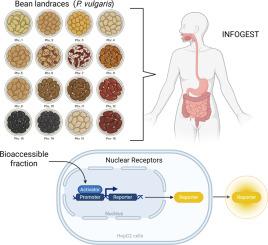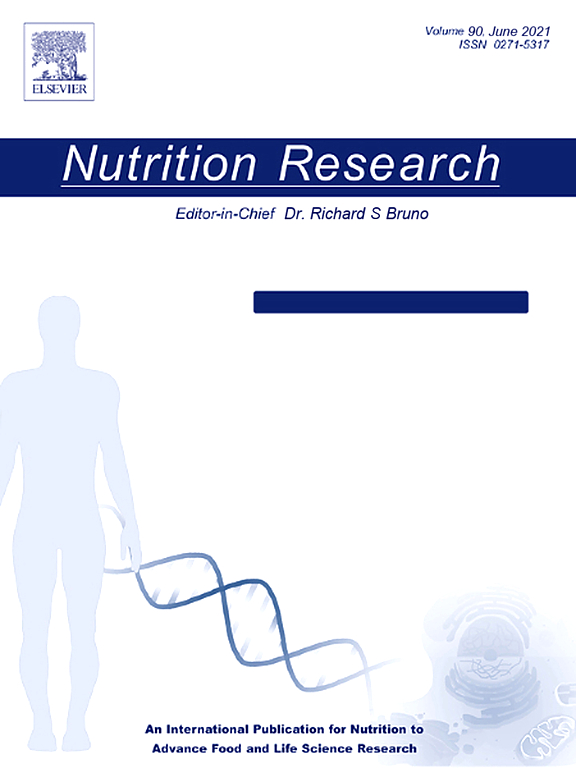从豆(Phaseolus vulgaris L.)地方种中提取的生物可及化合物可激活瞬时转染的HepG2细胞中的PPARγ
IF 3.1
3区 医学
Q2 NUTRITION & DIETETICS
引用次数: 0
摘要
普通豆类(Phaseolus vulgaris L.)是一种营养丰富的主食,与降低非传染性慢性病的风险有关。一种被提出的机制涉及核受体的调节,特别是过氧化物酶体增殖激活受体(PPARs),它们是脂质和碳水化合物代谢的关键调节因子。在这项研究中,我们评估了体外消化的面粉、次级代谢物富集提取物(SMEEs)、它们的组分,以及从14个地方品种和2个商业紫荆样品中选择的具有代表性的植物化学物质,在瞬时转染的HepG2细胞中直接激活ppar和其他核受体。我们假设从消化的地方菌种中提取的生物可及化合物会直接激活HepG2细胞中的PPARγ。Magnum和Peumo等地方品种消化后的面粉对ppar γ - 1和ppar γ - 2的活性均显著提高,达到对照组的1.54倍(P < 0.05)。相应的中小企业表现出更强的活性,与对照组相比,激活率高达2.32倍(P < 0.05)。相反,基于极性的部分或主要鉴定的植物化学物质(山奈酚-3- o -糖苷,sojasaponin Ba和Bb)均没有显着作用。这些发现表明,消化的寻常草基质含有能够直接激活HepG2细胞中的PPARγ的生物可及化合物,可能是通过协同相互作用或未知成分。这一机制证据支持了传统大豆地方品种在针对代谢健康的精确营养策略中的功能相关性。本文章由计算机程序翻译,如有差异,请以英文原文为准。

Bioaccessible compounds from bean (Phaseolus vulgaris L.) landraces activate PPARγ in transiently transfected HepG2 cells
Common beans (Phaseolus vulgaris L.) are a nutrient-dense staple food associated with a reduced risk of noncommunicable chronic diseases. One proposed mechanism involves the modulation of nuclear receptors, particularly peroxisome proliferator-activated receptors (PPARs), which are key regulators of lipid and carbohydrate metabolism. In this study, we evaluated the effects of in vitro digested flours, secondary metabolite-enriched extracts (SMEEs), their fractions, and selected representative phytochemicals from 14 landraces and 2 commercial P. vulgaris samples to directly activate PPARs and other nuclear receptors using a luciferase reporter assay in transiently transfected HepG2 cells. We hypothesized that bioaccessible compounds from the digested landraces would directly activate PPARγ in HepG2 cells. Digested flours from landraces such as Magnum and Peumo significantly activated both PPARγ1 and PPARγ2, reaching values up to 1.54-fold higher than the controls (P < .05). Corresponding SMEEs showed stronger activities, with up to 2.32-fold activation compared to the controls (P < .05). In contrast, none of the polarity-based fractions or the major identified phytochemicals (kaempferol-3-O-glycoside, sojasaponin Ba and Bb) showed significant effects. These findings demonstrate that digested P. vulgaris matrices contain bioaccessible compounds capable of directly activating PPARγ in HepG2 cells, likely through synergistic interactions or unidentified constituents. This mechanistic evidence supports the functional relevance of traditional bean landraces in precision nutrition strategies targeting metabolic health.
求助全文
通过发布文献求助,成功后即可免费获取论文全文。
去求助
来源期刊

Nutrition Research
医学-营养学
CiteScore
7.60
自引率
2.20%
发文量
107
审稿时长
58 days
期刊介绍:
Nutrition Research publishes original research articles, communications, and reviews on basic and applied nutrition. The mission of Nutrition Research is to serve as the journal for global communication of nutrition and life sciences research on diet and health. The field of nutrition sciences includes, but is not limited to, the study of nutrients during growth, reproduction, aging, health, and disease.
Articles covering basic and applied research on all aspects of nutrition sciences are encouraged, including: nutritional biochemistry and metabolism; metabolomics, nutrient gene interactions; nutrient requirements for health; nutrition and disease; digestion and absorption; nutritional anthropology; epidemiology; the influence of socioeconomic and cultural factors on nutrition of the individual and the community; the impact of nutrient intake on disease response and behavior; the consequences of nutritional deficiency on growth and development, endocrine and nervous systems, and immunity; nutrition and gut microbiota; food intolerance and allergy; nutrient drug interactions; nutrition and aging; nutrition and cancer; obesity; diabetes; and intervention programs.
 求助内容:
求助内容: 应助结果提醒方式:
应助结果提醒方式:


